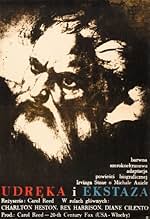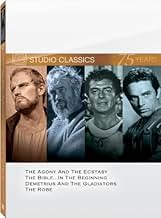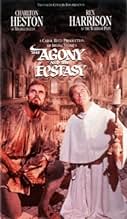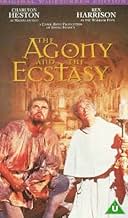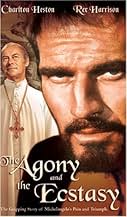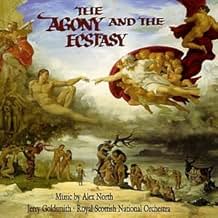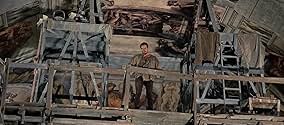AVALIAÇÃO DA IMDb
7,2/10
8,6 mil
SUA AVALIAÇÃO
A história biográfica dos problemas de Miguel Ângelo enquanto pintava a Capela Sistina sob o mando do Papa Júlio II.A história biográfica dos problemas de Miguel Ângelo enquanto pintava a Capela Sistina sob o mando do Papa Júlio II.A história biográfica dos problemas de Miguel Ângelo enquanto pintava a Capela Sistina sob o mando do Papa Júlio II.
- Direção
- Roteiristas
- Artistas
- Indicado a 5 Oscars
- 3 vitórias e 9 indicações no total
Fortunato Arena
- Pope's Bodyguard
- (não creditado)
Lars Bloch
- Baron Von Silenen
- (não creditado)
Angelo Boscariol
- Papal Guard
- (não creditado)
Calisto Calisti
- Physician
- (não creditado)
Amerigo Castrighella
- Quarry cart assistant
- (não creditado)
Anita Ceccotti
- Woman Under the Chapel
- (não creditado)
Enrico Chiappafreddo
- Tavern Customer
- (não creditado)
- Direção
- Roteiristas
- Elenco e equipe completos
- Produção, bilheteria e muito mais no IMDbPro
Avaliações em destaque
'Agony and the Ecstasy' is one heck of an attempt to be a big of a movie as possible. It's details the story of Pope Julius's commissioning of a reluctant Michelangelo to paint the roof of the Sistine chapel fer heaven's sakes!! It also two of the stars That Mattered In The 60's, Rex Harrison playing the Pope and Charlton Heston as Michelangelo! AND it runs for 2 and a half hours! I mean, this movie must mean something if they have a mini-biography of Michelangelo for the first 15 minutes, right? OK, despite it's too long running length, the movie is a fun sit through actually. It's not exactly a pompous costumed historical drama as it looks, sure there's a lot material covered here, but Heston and Harrison keep the story going quite well with their great portrayals here. I had seen this several years ago, and while Heston is good, it's Harrison who got my attention this time out, as his total control freak Pope character is quite entertaining to watch.
So again, a bit lengthy, but still entertaining.
So again, a bit lengthy, but still entertaining.
When you think about it, making a movie about artistry is pretty hard. Painting, writing, sculpting, music, whatever, it's not easy to make the act very interesting--painting is painstaking, it takes a long time. But in this movie, they succeed. Not just making a movie, but making an epic, a massive movie out of an act of creation, is a tough thing to do. But they really do succeed. At the heart of the movie isn't really the act of creation, or the passion for it, or even the ceiling itself--it's the adversarial relationship between Rex Harrison (Pope Julius II) and Charlton Heston (Michaelangelo).
It's certainly not that passion and creation are not here, it's just that they enrich the story about two men and their relationship. When Julius comes into the chapel in the middle of the night, and Michaelangelo is invariably there, there's a bond, even with silent incipient tension.
Heston is of course the only person for this role, as epics go, he's the best. For some reason he manages not to be overcome by the massive scale of these sorts of movies--something that happens to almost everyone else (look at Sinatra and Cary Grant in "the Pride and the Passion", they are totally lost in the grande scale, and they're the incomparable Grant and the larger than life Sinatra, not much more to be said there). Heston makes a solid tortured artist and Rex Harrison is quite wonderful as the Pope. He communicates the strength and intelligence of a Pope who loves art but must go to battle to preserve all that he holds dear. There's a scene when the Pope wants people to see the half completed chapel, since he has grown impatient with the time and when Michaelangelo bitterly objects, Harrison explodes with anger--extremely effective. When Harrison passed, it was truly a loss to movies.
There are flaws, no question, and it's not Heston's best work, course, once you've done Ben Hur and the Ten Commandments, nothing else is going to be your best work. The subplot with the sort of love interest is pretty silly, and it goes on a bit too long. The earnestness of the faith in the church, the sincerity of Heston when he says "Holiness" to the pope, a man that drives him crazy, is poignant. His faith is deep, almost as if he derives his love of art from a love of God. There are even some nice moments of levity as when a spattered Michaelangelo spits out a gob of paint and it lands near a watching Julius; or when the Pope creates a cardinal out of teen for payment in order to keep up the painting.
When it comes to big movies, this definitely lays with a handful of others that will never be surpassed--Titanic tried to be this kind of movie, and proves that even with $200 million and all the nifty gizmos of the modern age, it's very difficult to do; c'mon, Rex Harrison and Charlton Heston compared to Leo DeCaprio and Billy Zane--not much of a contest there.
See the movie, forgive it its flaws and appreciate the richness and nuance of the relationship between Pope and Artist.
It's certainly not that passion and creation are not here, it's just that they enrich the story about two men and their relationship. When Julius comes into the chapel in the middle of the night, and Michaelangelo is invariably there, there's a bond, even with silent incipient tension.
Heston is of course the only person for this role, as epics go, he's the best. For some reason he manages not to be overcome by the massive scale of these sorts of movies--something that happens to almost everyone else (look at Sinatra and Cary Grant in "the Pride and the Passion", they are totally lost in the grande scale, and they're the incomparable Grant and the larger than life Sinatra, not much more to be said there). Heston makes a solid tortured artist and Rex Harrison is quite wonderful as the Pope. He communicates the strength and intelligence of a Pope who loves art but must go to battle to preserve all that he holds dear. There's a scene when the Pope wants people to see the half completed chapel, since he has grown impatient with the time and when Michaelangelo bitterly objects, Harrison explodes with anger--extremely effective. When Harrison passed, it was truly a loss to movies.
There are flaws, no question, and it's not Heston's best work, course, once you've done Ben Hur and the Ten Commandments, nothing else is going to be your best work. The subplot with the sort of love interest is pretty silly, and it goes on a bit too long. The earnestness of the faith in the church, the sincerity of Heston when he says "Holiness" to the pope, a man that drives him crazy, is poignant. His faith is deep, almost as if he derives his love of art from a love of God. There are even some nice moments of levity as when a spattered Michaelangelo spits out a gob of paint and it lands near a watching Julius; or when the Pope creates a cardinal out of teen for payment in order to keep up the painting.
When it comes to big movies, this definitely lays with a handful of others that will never be surpassed--Titanic tried to be this kind of movie, and proves that even with $200 million and all the nifty gizmos of the modern age, it's very difficult to do; c'mon, Rex Harrison and Charlton Heston compared to Leo DeCaprio and Billy Zane--not much of a contest there.
See the movie, forgive it its flaws and appreciate the richness and nuance of the relationship between Pope and Artist.
The picture deals with Michelangelo or Michael Angel (Charlton Heston) who is working on the Carrara's marble creating sculptures and he is then ordered by Pope Julius II (Rex Harrison) the painting of as called Sistine chapel (that's why it was built by Pope Sisto) . Meanwhile , they'll develop various relationships with other Renaissance's important people . The film is correctly based on historical deeds and appearing famous roles , such as : Raphael (Tomas Milian) who shows up painting the ¨Athenas' school¨, Bramante (Harry Andrews) builder of the Vatican dome that hold his name , Girlandaio , Florence Medicis' descendants (Diane Cilento and Adolfo Celi) and duke of Urbin (Alberto Lupo). Besides , the film paces itself the confrontation between Julius II troops and the French/German army for the possession of the Pope's states . There are epic and impressive battles where the Pope himself fights enemies . The motion picture describes specially the creation of the enormous paintings on the ceiling and the difficulties that Michael Angel is suffering to achieve the immortal legacy . The Pope Julio II will also assign him the realization of his tomb .
The feature movie obtained a limited success and had a moderated box-office ; however , being nowadays better valued than the past . First-range acting by the two main actors : Charlton Heston and Rex Harrison , both of whom are magnificent . However , Rex Harrison did not get along with Charlton Heston at all during shooting ; in fact , twelve years later, while filming as secondary actors ¨Crossed swords¨ (1977) directed by Richard Fleischer , Rex avoided him utterly . Leon Shamroy's cinematography is rousing , the colorful paintings are glowing and brilliant ; spectacularly showing Bible's scenes at the Sistine Chapel . Alex North musical score is riveting (like ¨Spartacus¨ who he equally composed) . The sets are overwhelming and breathtaking , they were stunningly designed by production designer John De Cuir . In addition , evocative as well as adequate costumes by Oscarized Vittorio Nino Novarese . Carol Reed production and direction were excellent , he'd got much experience through a long career and had directed other classic movies (The third man) . Rating: Very good , above average and well worth seeing.
The feature movie obtained a limited success and had a moderated box-office ; however , being nowadays better valued than the past . First-range acting by the two main actors : Charlton Heston and Rex Harrison , both of whom are magnificent . However , Rex Harrison did not get along with Charlton Heston at all during shooting ; in fact , twelve years later, while filming as secondary actors ¨Crossed swords¨ (1977) directed by Richard Fleischer , Rex avoided him utterly . Leon Shamroy's cinematography is rousing , the colorful paintings are glowing and brilliant ; spectacularly showing Bible's scenes at the Sistine Chapel . Alex North musical score is riveting (like ¨Spartacus¨ who he equally composed) . The sets are overwhelming and breathtaking , they were stunningly designed by production designer John De Cuir . In addition , evocative as well as adequate costumes by Oscarized Vittorio Nino Novarese . Carol Reed production and direction were excellent , he'd got much experience through a long career and had directed other classic movies (The third man) . Rating: Very good , above average and well worth seeing.
like many historical films from the same age of Hollywood, the word "impressive" is the first to say. not only for its status of epic drama, costumes and the translation in image of a period. but, maybe , more important, for the admirable clash between Rex Harrison and Charlton Heston. and for the feel than a great story has its right and fair adaptation. because something impose "The Agony and the Ectasy" as special. not the biography of a great artist - and the admirable virtue is to know than Heston is Michelangelo not only act him - but the chance to discover yourself. the film, like the book, it is a beautiful eulogy to the life. using a genius as character of a kind of parable about art, proud, honesty and desire. so, just impressive. in this case - a word with deep roots.
The film is an epic grandeur feature of a interpersonal tug-of-war between the maestro Michelangelo and Pope Julius II.
I cannot help being shell-shocked to see the reconstruction of the magnificent ceiling though recognizably most of which is the trickery of montage (not in the real the Sistine Chapel, the location was inside Cinecitta Italy instead), but bathing under the glamour and solemnness of the visual wonders, I am stunned to exude my admiration and awe!
The two leads conspicuously stimulate a Moses versus Caesar confrontation, Charlton Heston seems to be more boorish than artistic to manifest a struggled Michelangelo, may God doesn't distinguish his people by their looks. The "agony and ecstasy" is watered down to an underwhelming stalemate thanks to Charlton's outlandish incarnation as the most eminent artist of that time. Rex Harrison, is by far and large worthy another Oscar nomination for his arresting devotedness, which is apt to impress the audience with a mind-blowing bi-polar characterization while good and evil coexist at the same time.
The film was a grave box office fiasco when it came out in 1965, however, judging by my appraisement, its merits still can be appreciated by our generation (a well-balanced script, the haunting original score and all the props and settings). However, the film entirely skipped Michelangelo's sexual orientation and awkwardly ploys a portentous conversation between Michelangelo and his admirer Contessina de'Medici (a over-wise Diane Cilento), which unveiled its cowardliness and helplessness.
My final remark is that as time goes by ruthlessly, art stands still and never fades away, so lucky enough cinema is yet a part of it.
I cannot help being shell-shocked to see the reconstruction of the magnificent ceiling though recognizably most of which is the trickery of montage (not in the real the Sistine Chapel, the location was inside Cinecitta Italy instead), but bathing under the glamour and solemnness of the visual wonders, I am stunned to exude my admiration and awe!
The two leads conspicuously stimulate a Moses versus Caesar confrontation, Charlton Heston seems to be more boorish than artistic to manifest a struggled Michelangelo, may God doesn't distinguish his people by their looks. The "agony and ecstasy" is watered down to an underwhelming stalemate thanks to Charlton's outlandish incarnation as the most eminent artist of that time. Rex Harrison, is by far and large worthy another Oscar nomination for his arresting devotedness, which is apt to impress the audience with a mind-blowing bi-polar characterization while good and evil coexist at the same time.
The film was a grave box office fiasco when it came out in 1965, however, judging by my appraisement, its merits still can be appreciated by our generation (a well-balanced script, the haunting original score and all the props and settings). However, the film entirely skipped Michelangelo's sexual orientation and awkwardly ploys a portentous conversation between Michelangelo and his admirer Contessina de'Medici (a over-wise Diane Cilento), which unveiled its cowardliness and helplessness.
My final remark is that as time goes by ruthlessly, art stands still and never fades away, so lucky enough cinema is yet a part of it.
Você sabia?
- CuriosidadesThe book on which this movie is based covers the entire life of Michelangelo Buonarroti. This movie based on a single chapter. One of the shortest, if not the shortest, in the entire book.
- Erros de gravaçãoAs shown in the movie, Michelangelo created a flat wooden platform on brackets built out from holes in the wall, high up near the top of the windows. But contrary to what is depicted in the film, he did not lie on this scaffolding while he painted, but painted from a standing position.
- ConexõesEdited from Prologue: The Artist Who Did Not Want to Paint (1965)
Principais escolhas
Faça login para avaliar e ver a lista de recomendações personalizadas
- How long is The Agony and the Ecstasy?Fornecido pela Alexa
Detalhes
- Data de lançamento
- País de origem
- Idiomas
- Também conhecido como
- La agonía y el éxtasis
- Locações de filme
- Piazza del Popolo, Todi, Perugia, Umbria, Itália(St. Peter's Square scene)
- Empresa de produção
- Consulte mais créditos da empresa na IMDbPro
Bilheteria
- Orçamento
- US$ 10.000.000 (estimativa)
- Tempo de duração
- 2 h 18 min(138 min)
- Cor
- Proporção
- 2.20 : 1
Contribua para esta página
Sugerir uma alteração ou adicionar conteúdo ausente


